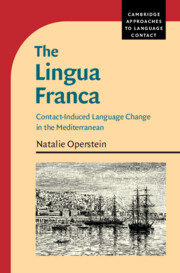Book contents
- The Lingua Franca
- Cambridge Approaches to Language Contact
- The Lingua Franca
- Copyright page
- Contents
- Tables
- Series Editor’s Foreword
- Abbreviations
- 1 Introduction
- 2 The Author
- 3 The Dictionnaire
- 4 The Orthography
- 5 The Lexicon
- 6 The Word Formation
- 7 The Inflection
- 8 The Syntax
- 9 The Lingua Franca
- Book part
- References
- Index
6 - The Word Formation
Published online by Cambridge University Press: 25 November 2021
- The Lingua Franca
- Cambridge Approaches to Language Contact
- The Lingua Franca
- Copyright page
- Contents
- Tables
- Series Editor’s Foreword
- Abbreviations
- 1 Introduction
- 2 The Author
- 3 The Dictionnaire
- 4 The Orthography
- 5 The Lexicon
- 6 The Word Formation
- 7 The Inflection
- 8 The Syntax
- 9 The Lingua Franca
- Book part
- References
- Index
Summary
This chapter examines the word formation patterns of the Dictionnaire’s LF. Its purpose is twofold: to provide a descriptive analysis of the patterns, and to situate them in relation to the word formation patterns of LF’s Romance lexifiers and those of pidgins. To this end, the chapter first surveys the word formation mechanisms of the main Romance lexifiers of LF and pidgins (in Sections 6.1 and 6.2, respectively). Section 6.3 describes the predominant word formation pattern attested in the Dictionnaire and provides a preliminary discussion of LF noun and verb morphology. Sections 6.4–6.8 look, respectively, at suffixation, prefixation, suppletion, compounding, and multiword lexical expressions. Section 6.9 examines how the different word formation mechanisms interact in a single functional domain, that of valency/transitivity alternations. Section 6.10 summarizes the findings and relates them to the question of LF’s taxonomic status.
- Type
- Chapter
- Information
- The Lingua FrancaContact-Induced Language Change in the Mediterranean, pp. 173 - 205Publisher: Cambridge University PressPrint publication year: 2021

